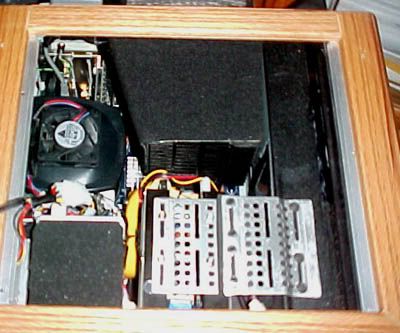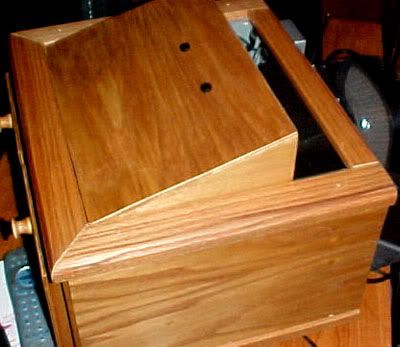First off....I'm not an engineer in this particular field. I'm just a duffer, with a bunch of computer stuff, and the ability to mod these things easily. This particular wooden case I've been tweaking, is well suited for experimentation. All the exhaust exits fron the top of the case (with the exception of the PSU which has an independant air path). The case fan blows in through the heatsink, makes a 90 degree turn, and goes out the top. This fan is thermal controlled with a sensor on the base of the heatsink. Changes in airflow that I make are immediately noticeable by changes in the fan speed and the CPU temp.
There is a fan under the hard drives (which are mounted vertically), blowing upward between the two drives, and out the top. Some of this aiflow also blows upward through the open area between the drives and the CPU heatsink. This airflow helps the CPU airflow make it's 90 degree turn to exit the case. The other fan visible in the photo vents the video card area and has little effect on the other temps. This fan and the HD fan are fixed at 5V. The only fan that changes speed is the CPU fan.

Since is only takes seconds to change the top, while the computer is running, I can easily monitor temp and fan speed changes. So far I have made four different tops, plus I can adjust the angle of each different top quickly with small spacers (while the computer is running). Here's the top design that gives the best CPU temps, with the lowest CPU fan speed....

So what's happening here? Why does this top give the CPU a slightly lower temp and a lower fan speed than no top at all. Well I think it has to do with the back pressure on the HD fan airflow. This airflow is somewhat forced toward the CPU heatsink with the addition of a top, and provides slightly more cooling to the CPU, allowing the CPU fan to slow down. In effect the airflow from the HD fan spends more time in the case.....and causes the CPU to cool better. The HD temps don't seem to be affected by this particular top.
I'll admit the temp and fan speed changes are only slightly in a positive direction, but every little bit helps. In a case with really poor airflow, this time thing might prove more effective. And I do have a problem with ambient temps in this computer testing area.....the ambient varies maybe 2C as the central AC turns on/off. Even a 1C change in the ambient, changes the CPU temp and fan speed. So any results I achieve are somewhat suspect.....considering the temp/fan speed changes are so slight when I adjust the top.
This is a difficult experiment to prove....or even to duplicate. But it's something to consider when designing an airflow technique.

Oh....what does this have to do with noise you ask? With a top on it, the computer is quieter when sitting in front of it. So it is reasonable for me to make a top that doesn't worsen the temps, maybe improve temps....


